ABSTRACT
Changes resulting from the cyclical nature of the sun’s energy output result to variations in thermosphere-ionosphere system parameters. The prolonged low solar activity period of solar cycle 23 provides an opportunity to study the thermosphere-ionosphere system parameters when the sun was at its ground state. The CHAMP satellite has provided wind data that can be used for investigation of neutral thermospheric parameters such as zonal winds and density. Using zonal wind data from 2006 to 2008 generated from CHAMP accelerometer readings using an iterative algorithm, the diurnal variation of averaged zonal thermospheric winds in the high latitudes (70 - 80°N) has been investigated. In the analysis we grouped the data into four seasons; the March and September equinoxes, and the June and December solstices. The wind data is binned into local time bins and averaged to find the hourly mean speeds. The results reveal maximum eastward and westward wind speeds going above 150 m/s for each of the seasons considered. Of particular interest is the observation that despite the expected complex behavior resulting from the expected magnetospheric inputs, the diurnal patterns are similar to those obtained in the mid-latitudes in an earlier study with data from this algorithm. Due to likely errors arising from the longitudinal effects of mixing composite solar times, there is need for simultaneous measurements in the high latitudes.
Key words: CHAMP satellite, high latitude, solar activity, thermosphere.
The thermosphere is the first layer of the earth’s atmosphere that receives the sun’s ultraviolet (UV) and extreme ultraviolet (EUV) radiations. These radiations ionize the neutral molecules that make up the thermosphere forming an embedded ionized region; the ionosphere. The thermosphere is coupled to the ionosphere by the interactions between the ionized and neutral species. A thorough understanding of thermospheric variability is important in establishing the state of the earth’s upper atmosphere. Thermospheric perturbations can arise from external forcing sources to which the thermosphere is coupled. The earth’s thermosphere-ionosphere system is coupled from above by interactions with incoming solar radiations and magnetospheric electric fields, and coupled to layers below by tides, gravity and planetary waves as shown in Figure 1. Thermospheric dynamics varies with solar cycle, solar flux, geomagnetic activity and change in seasons. The high latitude of the earth’s thermosphere is the site of interesting phenomena.
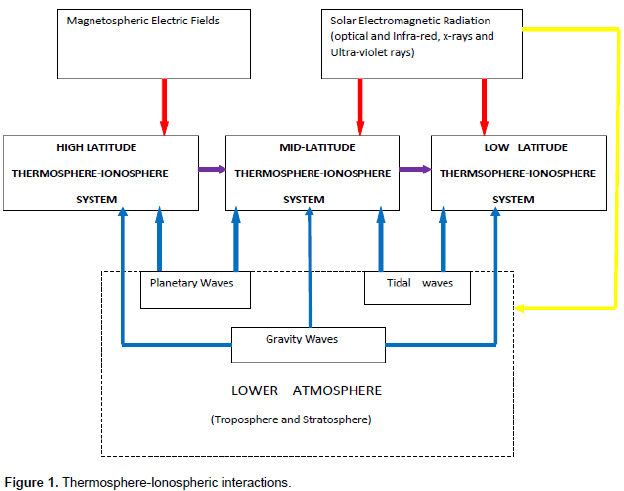
Charged particles coming from the sun are funneled into the earth’s upper atmosphere by the earth’s geomagnetic field. Thermodynamic and electrodynamic processes influence thermospheric wind behavior in high latitudes as there exists strong coupling between neutral particles and the plasma of the ionosphere in the auroral regions of the earth’s atmosphere (Lühr and Marker, 2013). Effects of solar disturbances are first observed in the high latitudes before onward propagation through mid to equatorial latitudes. The wind field and strength of earth’s high latitude is significantly modified by geomagnetic activity (Smith et al., 1988). It is the neutral wind parameter that has not received the much needed attention in regard to the many issues pertaining to the forecasting of ionospheric weather (Meriwether, 2006). Information on thermospheric composition and prevailing winds has been obtained using data from Fabry-Perot Inteferometers, Incoherent scatter radars and satellites (e.g. Emery et al., 1999; Thayer et al., 1987; Killeen et al., 1988; Aruliah et al., 1996; Fejer et al., 2000; Emmert et al., 2002; Liu et al., 2006; Häusler et al., 2007; Sutton et al., 2005; Sivla and McCreadie, 2014).
The interferometer technique has its limitation arising from uncertainty in emission height, restriction to dark hours, clear sky and reduced moon phases (Lühr et al., 2007). During periods of disturbed conditions the physical assumptions used by the radar technique break down (Liu et al., 2006). Insufficient data has hampered the investigation of these parameters in the earth’s upper thermosphere. Satellite observations of thermospheric winds have previously been carried out using data from the Dynamic explorer 2 satellites (e.g. Thayer et al., 1987). The investigations by Thayer al. (1987) were not detailed due to sparse sampling from the short-lived DE-2 mission in space (Lühr et al., 2011). Large density and wind data sets that can be used for upper thermospheric research have been generated from accelerometers flown in CHAMP and GRACE satellites. Investigations of thermospheric wind behaviour using data from accelerometer readings on board CHAMP satellite have been reported (e.g. Liu et al., 2006; Häusler et al., 2007; Förster et al., 2008; Sutton et al., 2005; Lühr et al., 2011; Sivla and McCreadie, 2014).
Using wind data derived from CHAMP satellite accelerometer using an iterative algorithm, Sivla and McCreadie (2014) successfully investigated seasonal diurnal thermospheric zonal wind behavior in the mid-latitudes during equinoxes. This iterative algorithm derived by Doornbos et al. (2010) is more reliable in that it avoids the restrictions and sources of error common in the direct algorithm. In this study we are extending our investigations to diurnal wind behavior in the north hemisphere high latitude (70 - 80°N) during the extreme low solar activity period (2006-2008) of solar cycle 23. The extended period of low solar activity in solar cycle 23 provides an opportunity to explore the diurnal behavior of the upper thermospheric parameters when the sun was at its ground state. A study of the earth’s upper thermosphere during periods of low solar activity can go a long way in helping us understand contributions from lower layers of earth’s atmosphere to variations in thermospheric parameters. The first high latitude thermospheric wind distribution investigation using data from CHAMP was carried out by Lühr et al. (2007). In their analysis of 131 days data centered on the June solstice of 2003 in the Polar Regions at altitudes of about 400 km, seasonal differences were observed to be significant in the dayside auroral zone than on the nightside. Their findings also revealed that zonal winds at sub-auroral latitudes from noon to dawn and dusk are very low during winter conditions.
Data sources and selection
The global Kp index is the mean value of the disturbance levels observed at 13 selected mid-latitude stations during the three-hour time intervals. According to a quasi-logarithmic scale it covers the range from 0 to 9. The geomagnetic planetary index, Ap, gives a measure of the level of geomagnetic activity over the entire Earth, for a given day. It is the daily average of the 3-hourly ap index, derived from the 3-hourly Kp values. The geomagnetic indices are retrieved from the World data Centre (WDC) for Geomagnetism, Kyoto (wdc.kugi.kyoto-u.ac.jp/wdc/sec3.html) whereas the absolute solar flux at 10.7 cm is obtained from National Geophysical Data Centre (
http://www.ngdc.noaa.gov). CHAMP was in a polar orbit and took 130 days to cover all local times and latitudes (Liu et al., 2006). The crossings of the latitude bands during the ascending and descending motions took place at different longitudes due the earth’s rotation. The relative position of the sun and the polar orbiting satellite changes little during the day so satellite measurements at the same geographic latitude although at different longitudes are within a small range of local time (Zhang and Shepherd, 2002). The tilting of the satellite orbit and latitudes establish the real local solar time coverage at particular geographic latitude.
The zonal wind used in this study is from the data derived by Doornbos et al. (2010) using an iterative algorithm. In this procedure, the modelled aerodynamic force is varied until it coincides with the observed acceleration (Ritter et al., 2010). Data at high latitudes from 70 - 80° north was selected for this study. The data covers the solar minimum period from 1st January, 2006 to 31st December, 2008, a total of 1096 days. The earth’s thermosphere has significant seasonal variations, thus the need to group the wind into appropriate seasons; the March equinox (February, March, April), the September equinox (August, September, October), the June solstice (May, June, July) and December solstice (November, December, January). This period spanning over three years provides enough data for detecting the diurnal variations at the different seasons. In general, solar activity may be different between March equinox and September equinox of a year (Chen et al., 2012), thus the need to separate the equinox seasons. Figure 2 shows the distribution of the wind speeds within the selected latitude band. The selected data is then binned into local time bins and averaged to find the mean speeds. The number of measurements in each local time bin each of the seasons is displayed in Figure 3.
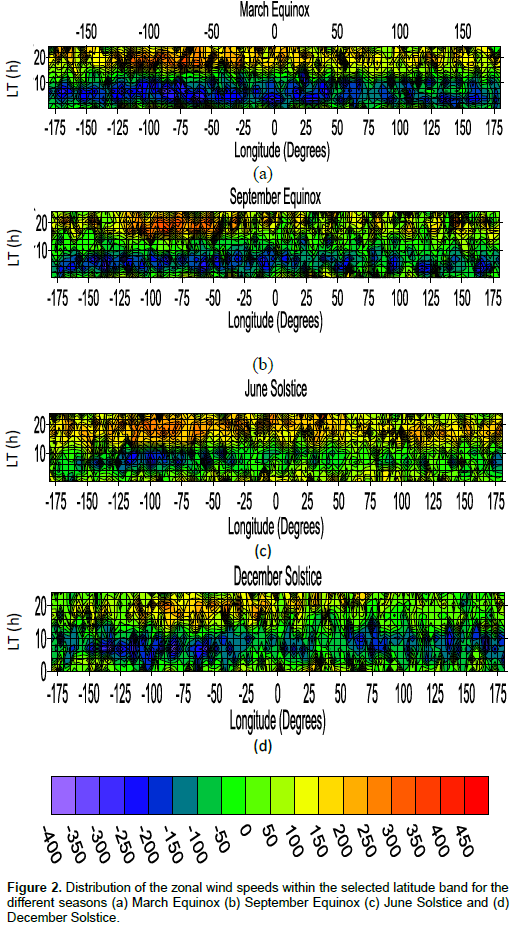
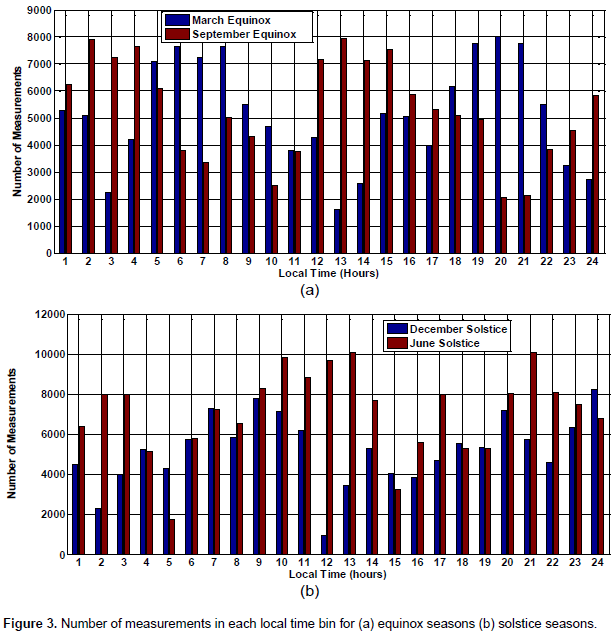
Figure 4 shows the Kp index, sunspot number, Ap index, geomagnetic and solar flux proxy variation during the period of study. The solar flux values are generally less than 100 s.f.u.. This period was characterized by very low Kp index values. The standard deviations in Figure 5 show the variability of the averaged winds. These deviations represented by the vertical bars are deviations of the winds for each one hour interval. The March and September equinox averaged winds show large standard deviations occurring in the late afternoon from about 1400 LT to 2100 LT. The large morning deviations during equinoxes are observed from 0200 LT to about 0800 LT. The deviation variation pattern is not well ordered during the June solstice. A large deviation during the June solstice is observed at 1200 LT and 1300 LT, with the largest occurring at 2300 LT. The December deviation pattern is similar to the March variation.
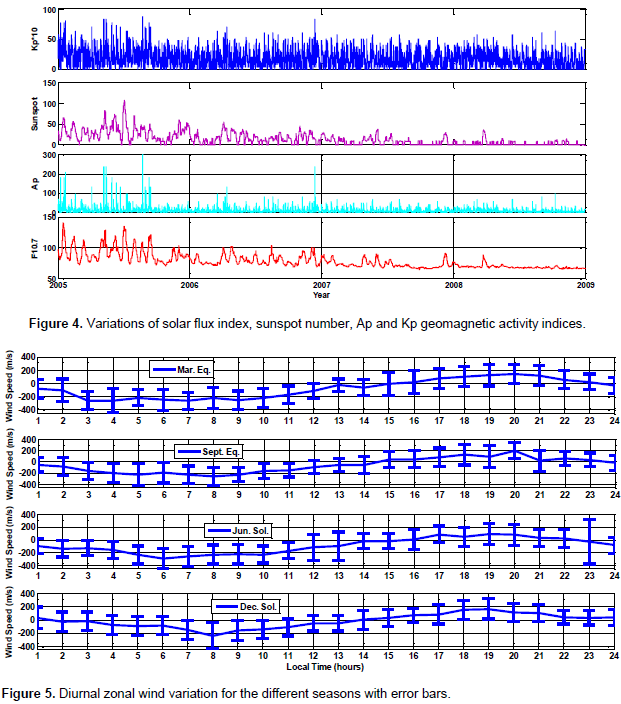
Equinox variation
During the March equinox season, maximum westward wind speeds going up to 260 m/s are observed at 0700 LT while eastward speeds of 145 m/s occur at 2000 LT. The west east switch in wind direction is observed to occur at about 1500 LT while east west switch is observed at about 2330 LT. The September equinox maximum westward and eastward speeds going above 250 and 200 m/s are observed at 0800 and 2000 LT, respectively. Change in wind direction from west to east occurred at about 1430 LT, while the change from east to west is observed at about 2330 LT.
Solstice variation
In the June solstice period, switch in wind direction from west to east is observed at 1600 LT, while the westward switch is observed at 2230 LT. Maximum westward speeds of about 295 m/s occurred at 0600 LT while maximum eastward speeds going close to 90 m/s is occurred at 1900 LT. For the December solstice season east to west switch was observed at about 0130 LT while change in direction from west to east was observed at 1400 LT. Maximum westward speeds of about 240 m/s occurred at 0800 LT while maximum eastward speeds of about 160 m/s occurred at 1900 LT.
During period of extreme low solar activity the earth’s ionosphere-thermosphere system is at its ground state. During this period of solar minimum, the high latitude thermospheric zonal winds may not be coupled efficiently to the pattern of ion drift movement leading to poor response to momentum forcing (Smith et al., 1988). The geomagnetic field geometry and the sun’s activity have a strong influence on the processes taking place in the earth’s high–latitude thermosphere (Lühr and Marker, 2013). The principal driving forces in high latitude upper themospheric zonal winds are the pressure gradient from solar heating and ion drag from ion-neutral collisions. The December solstice averaged winds lag behind the other seasons in the westward direction and generally lead the June solstice averaged winds during the morning hours as can be seen in Figure 6. On the dawn side plasma flow is aligned with the cross-polar cap wind at high latitudes (Lühr and Marker, 2013). In the northern hemisphere, the December solstice normally experience a shorter period of sunlight due to the position of the sun, leading to less contributions from the pressure gradient force to daytime wind flow.
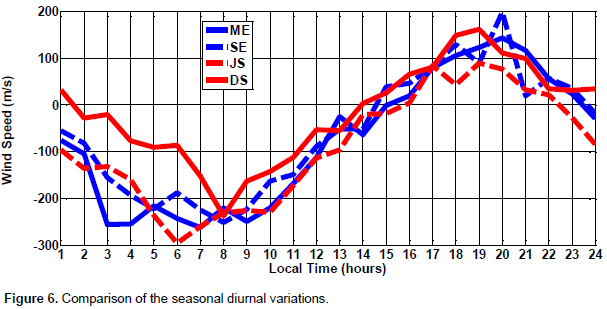
The June solstice averaged winds generally lead the other season’s averaged winds in the westward direction except the significant departure observed from 0200 to 0500 LT. They lag behind the other seasons in the eastward direction. The relative higher plasma density during the June solstice, March and September equinoxes may account for the relative high speeds observed in the morning. But again this does not explain the seemingly insignificant difference between the June and Equinox early morning diurnal wind variations. The eastward maximum speeds compare favorably well with those from the equatorial latitudes as can be observed in Figure 7. Solar heating may not be principal driving force of the high latitude winds, as equinoctial asymmetry is observed generally in the wind behavior. According to Aruliah et al. (1996), the asymmetry in high latitude winds originates from a seasonal and diurnal variation in the in the cross-polar –cap electric field generated by an equivalent variation in the inclination of the geomagnetic pole with respect to the average interplanetary magnetic field orientation. This may be a possible explanation as wind variation in the equatorial latitudes using the same data sets during the same period show less asymmetry as can be seen in Figure 7.
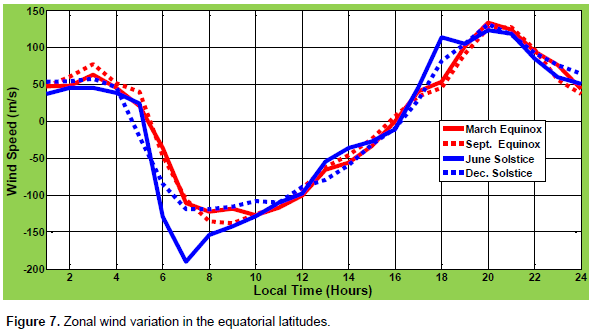
Compared to averaged wind variation in the equatorial latitudes the change in wind direction does not take place simultaneously. The switch in direction in the high latitudes which occurs generally takes one to two hours earlier in the westward to eastward direction. The westward switch takes place four to six hours earlier than in the equatorial latitudes as can be seen in Figures 6 and 7. As explained by Lühr et al. (2011), the observed dependence of zonal wind change in direction can be partly attributed to coriolis forces which cause earlier reversals at high latitudes. Compared to equatorial zonal wind variation, our high latitude winds showed high maximum speeds during the morning hours. Maximum westward direction speeds going above 200 m/s are observed as compared to maximum westward speeds of less than 150 m/s generally observed in the equatorial latitudes. The high speeds observed in the high latitude may be attributed to the prevailing effect of the electrodynamic and hydrodynamic forces. The pressure gradient force is the principal driving force of low latitude upper thermospheric zonal winds.
Using wind data from CHAMP accelerometer readings for three year data from 2006 to 2009, we have investigated diurnal wind variation in the north hemisphere high latitude during a period of extreme low solar activity. The main feature noticed from our analysis is the significant contributions from solar variation and ion drag to the wind patterns during this period of extreme low solar activity. Our analysis from the plots have shown
(1) December solstice averaged winds lag other seasons in the westward direction.
(2) some degree of asymmetry in equinox averaged winds. The asymmetry is observed to be more pronounced from midnight to morning hours.
(3) reversals in averaged speed wind direction occurring earlier than in averaged wind speeds in the equatorial latitudes.
(4) fast zonal flows at dawn. Maximum averaged winds occur in the westward direction during the day and generally larger in magnitude than eastward maximum speeds occurring in the evening.
Generally, our investigations have revealed that at this period of low extreme solar minimum, the upper thermospheric longitudinally averaged zonal winds have shown some degree of coupling to the moving ion drift patterns. Considering the coupling between neutral and plasma motions, the averaging of zonal wind speeds over altitudes between 200 km and 700 km could cause smearing of reversal time at different altitudes (Liu et al., 2006), as reversal time of zonal plasma drift varies within this range (Fejer et al., 1981). Thus there is need for observations at a constant height. Satellite coverage of the upper thermospheric parameters only provide LT constructs of diurnal variations combined together over long series of days, and such samples provide global averages where composite solar time changes are mixed with the poorly known “longitude effects” (Sambou et al., 1998). Thus the needs for simultaneous wind measurements. We recommend that further studies be carried out in geomagnetic coordinates in the north and south hemisphere using data from this algorithm. Due to the influence of electrodynamic forces there is need to present high latitude winds in geomagnetic coordinates.
The authors have not declared any conflict of interests.
The authors thank Doornbos for making his data available for this study.
REFERENCES
|
Aruliah AL, Farmer AD, Rees D (1996). The seasonal behaviour of high-latitude thermospheric winds and ion velocities observed over one solar cycle. J. Geophys. R. 15:701-711.
|
|
|
|
Chen Y, Liu L, Wan W, Ren Z (2012). Equinoctial Asymmetry in solar activity variations of NmF2 and TEC. Ann. Geophys. 30:613-622.
Crossref
|
|
|
|
|
Doornbos E, Van den Ijssel J, Lühr H, Forster M, Koppenwallner G (2010). Neutral density and crosswind determination from arbitrarily oriented multi-axis accelerometers on satellites. J. Spacecraft Rockets 4:580-589.
Crossref
|
|
|
|
|
Emery BA, Lathuillere C, Richards PG, Roble RG, Bounsanto MJ, Knipp DJ, Wilkinson P, Sipler DP, Niciejewski R (1999). Time dependent thermospheric neutral response to the 2-11 November 1993 storm period. J. Atmos. Sol. Terr. Phys. 61:329-350.
Crossref
|
|
|
|
|
Emmert JT, Fejer BG, Shepherd GG, Solheim BH (2002). Altitude dependence of middle and low-latitude daytime thermospheric disturbance winds measured by WINDII. J. Geophys. Res. 107(A12):1483.
Crossref
|
|
|
|
|
Fejer BG, Farley DT, Gonzales SA, Woodman RF, Calderon C (1981). F region east-west drifts at Jicamarca. J. Geophys. Res. 86:215-218.
Crossref
|
|
|
|
|
Fejer BG, Emmert JT, Shepherd GG, Solheim BH (2000). Average daytime F-region disturbance neutral winds measured by UARS: initial results. Geophys. Res. Lett. 27:1859-1862.
Crossref
|
|
|
|
|
Förster M, Rentz S, Köhler W, Liu H, Haaland SE (2008). IMF dependence of high-latitude thermospheric wind pattern derived from CHAMP cross-track measurements. Ann. Geophys. 26:1581-1595.
Crossref
|
|
|
|
|
Häusler K, Lühr H, Rentz S, Köhler W (2007). A statistical analysis of longitudinal dependencies of upper thermospheric zonal winds at dip equator latitudes derived from CHAMP. J. Atmos. Sol. Terr. Phys. 69:1419-1430.
Crossref
|
|
|
|
|
Killeen TL, Ponthieu JJ, Craven JD, Frank LA, Spencer NW (1988). On the relationship between dynamics of the polar thermosphere and morphology of the aurora- global-scale observations from Dynamics Explorers 1 and 2. J. Geophys. Res. 93:2675-2692.
Crossref
|
|
|
|
|
Liu H, Lühr H, Watanabe S, Kohler W, Henize V, Visser P (2006). Zonal Winds in the equatorial upper atmosphere. J. Geophy. Res. III:A07307.
|
|
|
|
|
Lühr H, Marker S (2013). High –latitude thermospheric density and wind dependence on solar and magnetic Activity. In: Lübken Ij. (eds) Climate and weather of the sun-earth System (CAWES). Atmospheric Sciences. Springer, Dordraht.
|
|
|
|
|
Lühr H, Park J, Ritte P, Lui H (2011). In-situ CHAMP observation of ionosphere-thermosphere coupling- Space Science Reviews. 168(1-4):237-260.
Crossref
|
|
|
|
|
Lühr H, Rentz S, Ritter P, Liu H, Haüsler K (2007). Average thermospheric wind patterns over the Polar Regions, as observed by CHAMP. Ann. Geophys. 25:1093-1101.
Crossref
|
|
|
|
|
Meriwether JW (2006). Studies of thermospheric dynamics with a Fabry-Perot interferometer network: A review. J. Atmos. Sol. Terr. Phys. 68:1576-1589.
Crossref
|
|
|
|
|
Ritter P, Lühr H, Doornbos E (2010). Substorm-related thermospheric density and wind disturbances derived from CHAMP observations. Ann. Geophys. 28:1207-1220.
Crossref
|
|
|
|
|
Sambou E, Vila PM, Kobea AT (1998). Non-trough foF2 enhancements at near equatorial dip latitudes. Ann. Geophys. 16:711- 720.
|
|
|
|
|
Smith RW, Rees D, Stewart RD (1988). Southern hemisphere thermospheric dynamics: A review. Rev. Geophys. 26(3):591-622.
Crossref
|
|
|
|
|
Sivla WT, McCreadie H (2014). Mid-latitude thermospheric zonal winds during equinoxes. Adv. Spac. Res. 54:499-508.
Crossref
|
|
|
|
|
Sutton EK, Forbes JM, Nerem RS (2005). Global thermospheric neutral density and wind response to the severe 2003 geomagnetic storms from CHAMP accelerometer data. J. Geophys. Res.110:A09S40.
Crossref
|
|
|
|
|
Thayer JP, Killeen TL, McCormac FG, Tschan CR, Ponthieu J-J, Spencer NW (1987). Thermospheric neutral wind signatures dependent on the east-west component of the interplanetary magnetic field for northern and southern Hemispheres, as measured from Dynamics Explorer-2. Ann. Geophys. 53:63-368.
|
|
|
|
|
Zhang SP, Shepherd GG (2002). Neutral wins and O (1S) emission rates in the lower thermosphere as measured with WINDII/UARS during the April 4-5th 1993 and February 1994 geomagnetic storms. J. Atmos. Sol-Terr. Phys. 64:1201-1214.
Crossref
|
|